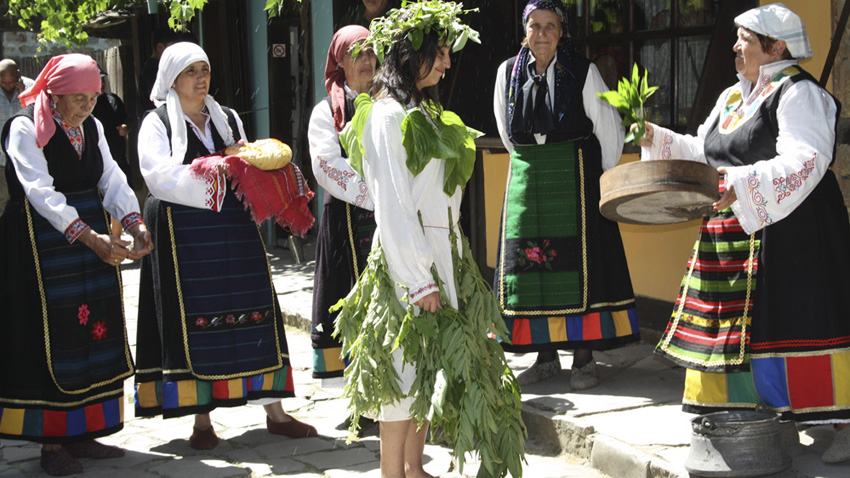Lime bark, curled in a circle with a bottom covered with stretched silk or with loosely woven cloth - this is how a sieve would be made in old times. As with all things used in the process of making bread, the sieve would to a great extent assume its magical power and paramount importance in the life of Bulgarians. In the Bulgarian language sieve goes like sito deriving from sit (meaning full, replete with food, and hence wealth and good life). The sieve is found in a range of rituals and practices - it was used for soothsaying but also for spoiling black magic. And in folk songs performed at the so-called zasevki before the wedding (when flour for the special wedding bread was being sifted) sieves were always silk, three or nine in number and trembling in the hands of girls holding them.
In the young girls' rituals of Butterfly and St. Lazarus girls tour the community, while their hosts give them various foods placed in a sieve. The same way mummers receive gifts while they go round villages. In some songs sung for the Butterfly girls' ritual, the following chant is included: „Come on, give away with the sieve for a full year!“ During the same ritual women soothsay about how rich the harvest will be. When the butterflies leave the house they have visited, the housewife rolls down the sieve. If it falls with its open side upwards, the year will be fertile and replete with food.
If there was a childless bride in the village, ritual bread for feasts (such as the winter feast of Varvara) was kneaded including magical actions with the sieve. The eldest woman in the family stood by the trough, and the bride began to sift the flour with the sieve held upside down. While she was doing that her elder relative would chant: “The way the sieve is turned, let the tummy is turned!” This meant that bad luck should be broken, so that the bride would be able to conceive.
The round shape of the sieve is another reason why this common household object is loaded with so much symbolism. As we know the circle means protected space. Therefore the clothes for a baby were put into a sieve in a bid to protect the newly born from illness. On the fortieth day after the birth of a baby, female friends and relatives were invited for celebration with a round loaf and an empty sieve was left at the table. In it the guests were expected to put various foods aimed to give health and good life to the young mother and her baby - onions, red peppers, eggs etc. A slice from the ritual loaf of bread aimed for the young mother was also put into the sieve. It was believed that if a woman ate even a single bread crumb from this slice she would be able to bear many children. In some regions of Bulgaria walnut were put in a sieve and then these were rocked - so that the child becomes energetic and joyful.

The sieve though is central to the wedding ritual. It is a synonym of the female side of the wedding. On the eve of the wedding, the bride's female friends take to the bridegroom, a belt, a waist-band and a kerchief in a sieve. While wedding bread is made, flour is sieved simultaneously with three sieves arranged one above the other. The wedding rings of the young couple are put in the flour that has gone through the sieving process. In traditional beliefs this is a way to sieve away all things standing in the way of the young couple leaving only the good and sound in their relationship. The special kosichnik loaf of bread is also put in a sieve and is taken to the bride. When the bridegroom's party enters the yard of the bride's house, she looks at the procession through a sieve trying to recognize the bridegroom. This is a kind of love magic - it is done so that her husband is satisfied with her and she is satisfied with him.
A sieve is used to take the grains thrown over the young couple. The round loaf of bread prepared by the mother of the bridegroom is also placed on a sieve so that their life is full. The Best Man brings the veil along with oats, dried fruit, sugar in a sieve. After the veil is raised from the bride's face it is put in a sieve. This unusual object is present in other moments of the wedding - from the very start all the way to the sweet rakiya brandy drink. One of the first things that newlyweds buy for their new home is a sieve hoping it will endow them with a full life together.
English Daniela Konstantinova
The feast of the Annunciation (Blagoveshtenie in Bulgaria) is a holy day , a symbol of God’s infinite mercy to people and especially to women, blessed to bear new life, but also an embodiment of the eternal human longing for something better in the..
Clocks and bells will ring out in the center of Stara Zagora on Saturday, when the city will host the XXIV Masquerade Games Festival . The event will start with a traditional parade of participants. Attractive babugers, araps, old men and other..
Today marks the 88th anniversary of the birth of remarkable Bulgaria folk singer Nadka Karadzhova . Born on March 14, 1937 in the then Pazardzhik village of Trivoditsi (today - Plovdiv region), she is a descendant of an old musical family. At the age..

+359 2 9336 661
